|
|
#61 | |
|
The Lurker
|
Quote:
Hope your exam went okay as well mate.
__________________
|
|
|
|

|
|
|
#62 |
|
Forum User
|
As far as cameras go, the Canon 20Da, while I'm not sure WHERE to get it, is designed specifically for astrophotography, being that it doesn't filter out infrared light and will produce higher contrast and sharper photos.
http://en.wikipedia.org/wiki/Eos_20d#EOS_20Da However apparently now there's a Canon 60Da which clearly would be more desirable for basically the same cost http://en.wikipedia.org/wiki/Canon_EOS_60Da#EOS_60Da Though these are quite pricey. What is your budget for the photographic end of this? With that telescope all you'll be needing is a body for the camera and either using it with a remote shutter, or simply plugging the camera into a laptop and doing it live. EDIT: Woops, didn't read that you've already been doing astrophotography. Either way, some more info if your camera isn't up to par :P
__________________
     
Last edited by Spenner; 04-6-2012 at 10:28 AM.. |
|
|

|
|
|
#63 |
|
⊙▃⊙
|
What's in the Sky Tonight?
April 6, 2012 -Full Moon (exact at 3:19 p.m. EDT). This evening the Moon shines in the east with Spica a little to its left and Saturn farther left a pretty lineup, as shown here. Farther to the Moon's right, look for the four-star pattern of Corvus, the Crow. Much farther to the upper left (outside the picture here) is bright Arcturus, the "Spring Star." -Mars (magnitude 0.7) shines bright fire-orange under the belly of Leo. Regulus is 5° to Mars's right in the evening, and Gamma Leonis is 7° above it. Mars was at opposition on March 3rd. Now it's fading and shrinking as Earth pulls ahead of it along our faster, inside-track orbit around the Sun. But at least Mars is shining higher in the evening sky now. It's highest in the south by around 10 or 11 p.m. daylight-saving time.  Astro Picture of the Day: April 6, 2012  Source: After wandering about as far from the Sun on the sky as Venus can get, the brilliant evening star crossed paths with the Pleiades star cluster earlier this week. The beautiful conjunction was enjoyed by skygazers around the world. Taken on April 2, this celestial group photo captures the view from Portal, Arizona, USA. Also known as the Seven Sisters, even the brighter naked-eye Pleiades stars are seen to be much fainter than Venus. And while Venus and the sisters do look star-crossed, their spiky appearance is the diffraction pattern caused by multiple leaves in the aperture of the telephoto lens. The last similar conjunction of Venus and Pleiades occurred nearly 8 years ago. As it did then, Venus will again move on to cross paths with the disk of the Sun in June. It is the last time in our lifetime that it will do so. Unless you plan to live through the late 22nd century. --------------- What's in the Sky Tonight Archive March 1, 2013 - July 31, 2013 Astro Pic of the Day Archive March 1, 2013 - July 31, 2013
__________________
1st in Kommisar's 2009 SM Tournament 1st in I Love You`s 2009 New Year`s Tournament 3rd in EnR's Mashfest '08 tournament 5th in Phynx's Unofficial FFR Tournament 9th in D3 of the 2008-2009 4th Official FFR Tournament 10th in D5 of the 2010 5th Official FFR Tournament 10th in D6 of the 2011-2012 6th Official FFR Tournament FMO AAA Count: 71 FGO AAA Count: 10 Bluearrowll = The Canadian player who can not detect awkward patterns. If it's awkward for most people, it's normal for Terry. If the file is difficult but super straight forward, he has issues. If he's AAAing a FGO but then heard that his favorite Hockey team was losing by a point, Hockey > FFR PS: Cool AAA's Terry - I Love You An Alarm Clock's Haiku beep beep beep beep beep beep beep beep beep beep beep beep beep beep beep beep beep - ieatyourlvllol Last edited by Bluearrowll; 01-25-2014 at 10:09 AM.. |
|
|

|
|
|
#64 | |
|
The Lurker
|
Quote:
Also, when i said "Do you think it'll be good for taking long exposures as well?" in my previous post, i was referring to the stability of the mount as i've read that a decent mount is required for astrophotography. I'm new to both astronomy and photography so bear with me if i sound clueless lol.
__________________
|
|
|
|

|
|
|
#65 | |
|
⊙▃⊙
|
Quote:
http://www.telescope.com/Mounts-Trip...e=SortByRating http://www.telescope.com/Mounts-Trip...ByRating#tab-6 Here are a couple tripods that would help you shoot long exposure pictures. One of them is considerably more expensive than the other, but remember these are dollar values, so for your currency they might be a bit cheaper. Both of them appear to have very positive reviews, which is typically a good sign of a good product. Also for the more inexpensive one, take a look at some of the photos that people have taken with it as a mount! What's in the sky tonight? April 7, 2012 -The bright Moon rises around the end of twilight below Saturn and Spica in the east-southeast. Later in the evening the three shine higher: a long, narrow triangle with the Moon at the bottom. -Saturn (magnitude +0.2, in Virgo) is at opposition April 15th. This week it rises almost around sunset and stands highest in the south around 1 or 2 a.m. daylight-saving time. Shining 5½° to Saturn's right is Spica: fainter, bluer, and twinklier. -Keep careful watch on Saturn and its rings in a telescope. In the days leading up to opposition, watch for the Seeliger effect: a brightening of the rings with respect to the globe. This happens because the solid particles making up the rings backscatter sunlight (reflect it back in the direction it came from) more effectively than the planet's cloudtops do. Astro Picture of the Day: April 7, 2012  Source: The star near the top is so bright that it is sometimes hard to notice the galaxy toward the bottom. Pictured above, both the star, Regulus, and the galaxy, Leo I, can be found within one degree of each other toward the constellation of the Lion (Leo). Regulus is part of a multiple star system, with a close companion double star visible to the lower left of the young main sequence star. Leo I is a dwarf spheroidal galaxy in the Local Group of galaxies dominated by our Milky Way Galaxy and M31. Leo I is thought to be the most distant of the several known small satellite galaxies orbiting our Milky Way Galaxy. Regulus is located about 75 light years away, in contrast to Leo 1 which is located about 800,000 light years away. Regulus is easy to spot these days as it is accompanied by Mars after sunset and hangs around until the early morning hours.
__________________
1st in Kommisar's 2009 SM Tournament 1st in I Love You`s 2009 New Year`s Tournament 3rd in EnR's Mashfest '08 tournament 5th in Phynx's Unofficial FFR Tournament 9th in D3 of the 2008-2009 4th Official FFR Tournament 10th in D5 of the 2010 5th Official FFR Tournament 10th in D6 of the 2011-2012 6th Official FFR Tournament FMO AAA Count: 71 FGO AAA Count: 10 Bluearrowll = The Canadian player who can not detect awkward patterns. If it's awkward for most people, it's normal for Terry. If the file is difficult but super straight forward, he has issues. If he's AAAing a FGO but then heard that his favorite Hockey team was losing by a point, Hockey > FFR PS: Cool AAA's Terry - I Love You An Alarm Clock's Haiku beep beep beep beep beep beep beep beep beep beep beep beep beep beep beep beep beep - ieatyourlvllol |
|
|
|

|
|
|
#66 |
|
⊙▃⊙
|
What's in the sky tonight?
April 8, 2012 -As twilight fades down, Look for bright Sirius in the southwest, Orion's horizontal Belt off to the right, and Aldebaran and Venus farther to the right in the west. They all form a long, almost straight line. The line is horizontal if you live near latitude 38° north. -Venus (magnitude –4.6; in Taurus) shines very high and ever more brilliant in the west during and after twilight. It doesn't set now until some 2½ hours after dark. This is just about as high and bright as Venus ever becomes in its 8-year cycle of apparitions. Look to its lower right for the Pleiades, and to its left for orange Aldebaran. Astro Picture of the Day: April 8, 2012 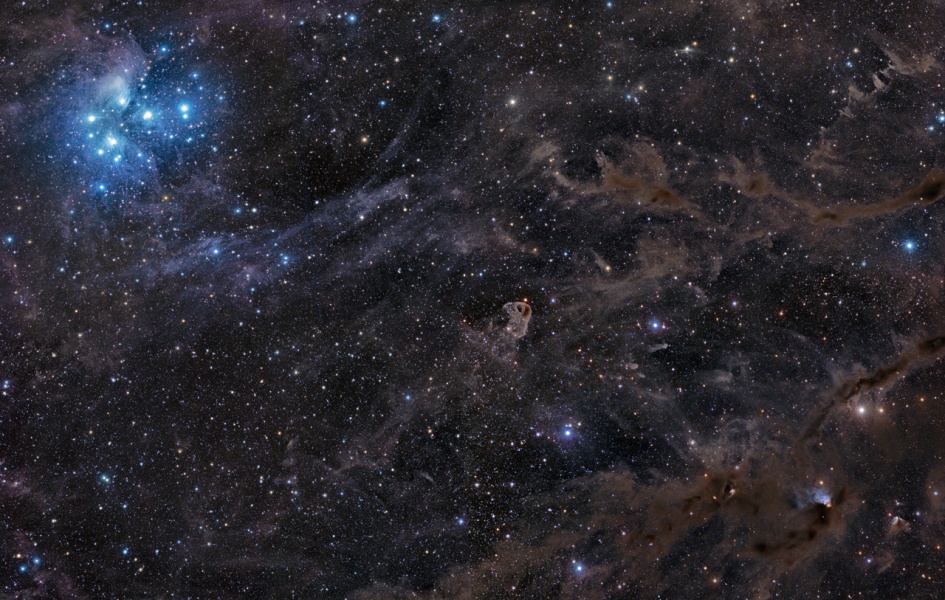 Source: Hurtling through a cosmic dust cloud some 400 light-years away, the lovely Pleiades or Seven Sisters star cluster is well-known for its striking blue reflection nebulae. In the dusty sky toward the constellation Taurus and the Orion Arm of our Milky Way Galaxy, this remarkable image shows the famous star cluster at the upper left. But lesser known dusty nebulae lie along the region's fertile molecular cloud, within the 10 degree wide field, including the bird-like visage of LBN 777 near center. Small bluish reflection nebula VdB 27 at the lower right is associated with the young, variable star RY Tau. At the distance of the Pleiades, the 5 panel mosaic spans nearly 70 light-years. The dust clouds are seen as brown clouds, not to be confused with clouds that might be seen in terrestrial levels.
__________________
1st in Kommisar's 2009 SM Tournament 1st in I Love You`s 2009 New Year`s Tournament 3rd in EnR's Mashfest '08 tournament 5th in Phynx's Unofficial FFR Tournament 9th in D3 of the 2008-2009 4th Official FFR Tournament 10th in D5 of the 2010 5th Official FFR Tournament 10th in D6 of the 2011-2012 6th Official FFR Tournament FMO AAA Count: 71 FGO AAA Count: 10 Bluearrowll = The Canadian player who can not detect awkward patterns. If it's awkward for most people, it's normal for Terry. If the file is difficult but super straight forward, he has issues. If he's AAAing a FGO but then heard that his favorite Hockey team was losing by a point, Hockey > FFR PS: Cool AAA's Terry - I Love You An Alarm Clock's Haiku beep beep beep beep beep beep beep beep beep beep beep beep beep beep beep beep beep - ieatyourlvllol |
|
|

|
|
|
#67 |
|
⊙▃⊙
|
What's in the sky tonight?
April 9, 2012 -The Big Dipper, high in the northeast, dumps water into the dim Little Dipper during evening at this time of year. -Jupiter is sinking ever lower toward the sunset far below Venus. Jupiter is rounding toward the far side of the Sun, which is why a telescope shows it a disappointingly small 33 arcseconds wide. In addition, Jupiter appears increasingly fuzzy at its ever-lower altitude. Astro Picture of the Day: April 9, 2012  Source: Strange shapes and textures can be found in neighborhood of the Cone Nebula. The unusual shapes originate from fine interstellar dust reacting in complex ways with the energetic light and hot gas being expelled by the young stars. The brightest star on the right of the above picture is S Mon, while the region just below it has been nicknamed the Fox Fur Nebula for its color and structure. The blue glow directly surrounding S Mon results from reflection, where neighboring dust reflects light from the bright star. The red glow that encompasses the whole region results not only from dust reflection but also emission from hydrogen gas ionized by starlight. S Mon is part of a young open cluster of stars named NGC 2264, located about 2500 light years away toward the constellation of the Unicorn (Monoceros). The origin of the mysterious geometric Cone Nebula, visible on the far left, remains a mystery.
__________________
1st in Kommisar's 2009 SM Tournament 1st in I Love You`s 2009 New Year`s Tournament 3rd in EnR's Mashfest '08 tournament 5th in Phynx's Unofficial FFR Tournament 9th in D3 of the 2008-2009 4th Official FFR Tournament 10th in D5 of the 2010 5th Official FFR Tournament 10th in D6 of the 2011-2012 6th Official FFR Tournament FMO AAA Count: 71 FGO AAA Count: 10 Bluearrowll = The Canadian player who can not detect awkward patterns. If it's awkward for most people, it's normal for Terry. If the file is difficult but super straight forward, he has issues. If he's AAAing a FGO but then heard that his favorite Hockey team was losing by a point, Hockey > FFR PS: Cool AAA's Terry - I Love You An Alarm Clock's Haiku beep beep beep beep beep beep beep beep beep beep beep beep beep beep beep beep beep - ieatyourlvllol |
|
|

|
|
|
#68 |
|
⊙▃⊙
|
This thread has now lasted one month! What has happened in that month?
-1,200 views. -67 posts. -31 Pictures and a month of learning what's in the sky that most of us can see. -Contributions from members about finding helpful links to astronomical related sites, cameras, telescopes. -A stickied thread. -1,200 views / 31 days means on average, 38.7 people view this thread a day. Thank you for helping this thread maintain its splendour. -Several new features, including a Light pollution map, Messier Map, new links. My question now comes to you, the viewer: What would you like to see added to this thread? Perhaps someone could make a neat banner to head the thread. I'm in the final exam period so I don't quite have the time to do it, but a major thank you to all who regularly view this thread! Now having said that... What's in the sky tonight? April 10, 2012 -The bright star high to the upper right of Venus these evenings is Capella, the Goat Star. It's the same yellow-white color, and thus the same temperature, as the Sun. The wavelength of the star is a good measurement of indicating how hot a star is. It's also how we know the temperature of our own sun! The shorter the wavelength, the warmer the star. Wavelengths are also used to calculate how fast the star is moving to, or from us by how much it has redshifted (how much the elemental spectra of a star has moved to the longer end of the spectrum compared to the elemental spectra at rest state found here, and as such, is moving away) or blueshifted (how much the elemental spectra of a star has moved to the shorter end of the spectrum compared to the elemental spectra at rest state found here, and as such, is heading towards us). The greater the shift, the faster the object is moving to or from us. -You can see Venus in the clear blue sky of daytime, if your eye lands right on it. The best time to examine Venus in a telescope is late afternoon or around sunset. It's now a thick crescent that has grown to 27 arcseconds tall as it rounds the Sun and approaches Earth. Astro Picture of the Day: April 10, 2012 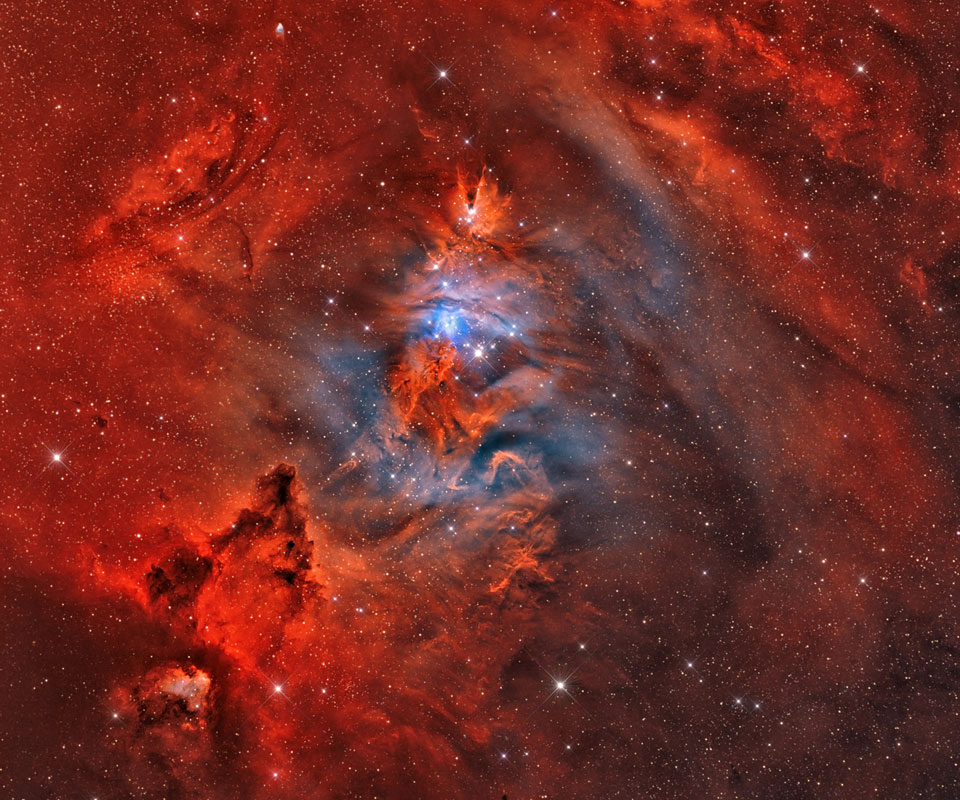 Source: Does part of this image look familiar? In the second picture in as many days, the Cone Nebula is revisited with its many friends in a more zoomed out scale. Found in Monoceros, pictured above is a star forming region cataloged as NGC 2264, the complex jumble of cosmic gas and dust is about 2,700 light-years distant and mixes reddish emission nebulae excited by energetic light from newborn stars with dark interstellar dust clouds. Where the otherwise obscuring dust clouds lie close to the hot, young stars they also reflect starlight, forming blue reflection nebulae. The above image spans about 3/4 degree or nearly 1.5 full moons, covering 40 light-years at the distance of NGC 2264. Its cast of cosmic characters includes the Fox Fur Nebula, whose convoluted pelt lies at the upper left, bright variable star S Mon immersed in the blue-tinted haze just below the Fox Fur, and the Cone Nebula near the tree's top. Of course, the stars of NGC 2264 are also known as the Christmas Tree star cluster. The triangular tree shape traced by the stars appears sideways here, with its apex at the Cone Nebula and its broader base centered near S Mon.
__________________
1st in Kommisar's 2009 SM Tournament 1st in I Love You`s 2009 New Year`s Tournament 3rd in EnR's Mashfest '08 tournament 5th in Phynx's Unofficial FFR Tournament 9th in D3 of the 2008-2009 4th Official FFR Tournament 10th in D5 of the 2010 5th Official FFR Tournament 10th in D6 of the 2011-2012 6th Official FFR Tournament FMO AAA Count: 71 FGO AAA Count: 10 Bluearrowll = The Canadian player who can not detect awkward patterns. If it's awkward for most people, it's normal for Terry. If the file is difficult but super straight forward, he has issues. If he's AAAing a FGO but then heard that his favorite Hockey team was losing by a point, Hockey > FFR PS: Cool AAA's Terry - I Love You An Alarm Clock's Haiku beep beep beep beep beep beep beep beep beep beep beep beep beep beep beep beep beep - ieatyourlvllol |
|
|

|
|
|
#69 | |
|
Forum User
|
Quote:
 ) )
__________________
     
|
|
|
|

|
|
|
#70 |
|
⊙▃⊙
|
What's in the sky tonight?
April 11, 2012 -With the Moon gone from the evening sky, it's deep-sky observing time again. Telescope users are familiar with the "Leo Trio" of galaxies (M65, M66, and NGC 3628) by the little chair asterism in the back leg of Leo. Can you detect M65 and M66 with binoculars? -Toronto residents should consider the International Space Station Tracker as the Space Station makes very visible passes over the city tonight and an even brighter appearance tomorrow night at a reasonable hour. There will be two passes tonight: Pass A: This pass rises above the horizon at 20:20:54, and enters the shadow of the Earth at 20:30:09. The maximum altitude time is 20:25:52, and it will appear 26 degrees high at its peak. At it's peak it will appear in the Southeast. Event Time Altitude Azimuth Distance (km) Rises above horizon 20:20:54 -0° 209° (SSW) 2,283 Reaches 10° altitude 20:23:09 10° 196° (SSW) 1,435 Maximum altitude 20:25:52 26° 138° (SE ) 818 Enters shadow 20:30:09 3° 69° (ENE) 1,998 Drops below 10° altitude20:28:40 10° 78° (ENE) 1,446 Use the following star map to get a feel for the location and how fast the space station travels throughout it's ~6 minute appearance. More details can be found in the link in "Pass A". Pass B: This is the better of the two passes tonight. At its peak, the space station will be almost 300 km closer to us, and the sun will also have long set. The maximum altitude will be 45 degrees - halfway up the sky. Event Time Altitude Azimuth Distance (km) Rises above horizon 21:56:46 0° 253° (WSW) 2,292 Reaches 10° altitude 21:58:52 10° 260° (W ) 1,442 Maximum altitude 22:02:00 45° 335° (NNW) 553 Enters shadow 22:02:37 39° 10° (N ) 615 Use the following star map to get a feel for the location and how fast the space station travels throughout it's ~6 minute appearance. More details can be found in the link in "Pass B". NOTE: These times are specifically calculated for TORONTO, ON. If you're interested and wish to have a shot at looking at the Space Station, open the "International Space Station Tracker" tab in this thread, and follow the instructions. Good luck, and don't blink! Astro Picture of the Day: April 11, 2012 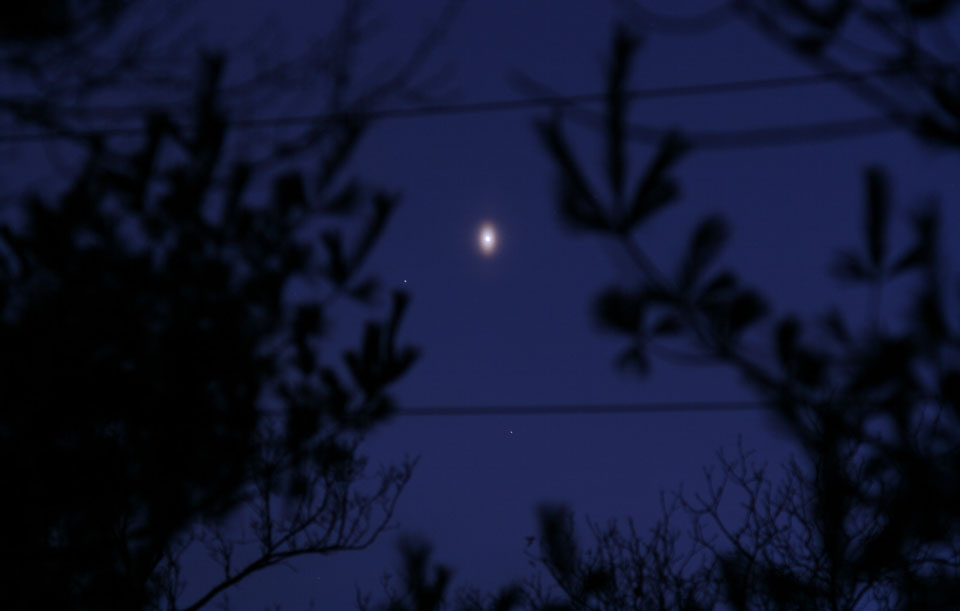 Source: Why would Venus appear oval? Venus has been seen countless times from the surface of the Earth, and every time the Earth's atmosphere has dispersed its light to some degree. When the air has just the right amount of dust or water droplets, small but distant objects like Venus appear spread out into an angularly large aureole. Aureoles are not unusual to see and are frequently noted as circular coronas around the Sun or Moon. Recently, however, aureoles have been imaged that are not circular but distinctly oval. The above oval Venusian aureole was imaged by the astrophotographer who first noted the unusual phenomenon three years ago. Initially disputed, the unusual distortion has now been confirmed multiple times by several different astrophotographers. What causes the ellipticity is currently unknown, and although several hypotheses hold that horizontally oriented ice crystals are responsible, significant discussions about it are still taking place.
__________________
1st in Kommisar's 2009 SM Tournament 1st in I Love You`s 2009 New Year`s Tournament 3rd in EnR's Mashfest '08 tournament 5th in Phynx's Unofficial FFR Tournament 9th in D3 of the 2008-2009 4th Official FFR Tournament 10th in D5 of the 2010 5th Official FFR Tournament 10th in D6 of the 2011-2012 6th Official FFR Tournament FMO AAA Count: 71 FGO AAA Count: 10 Bluearrowll = The Canadian player who can not detect awkward patterns. If it's awkward for most people, it's normal for Terry. If the file is difficult but super straight forward, he has issues. If he's AAAing a FGO but then heard that his favorite Hockey team was losing by a point, Hockey > FFR PS: Cool AAA's Terry - I Love You An Alarm Clock's Haiku beep beep beep beep beep beep beep beep beep beep beep beep beep beep beep beep beep - ieatyourlvllol |
|
|

|
|
|
#71 |
|
Forum User
|
As well, I forgot about some key points that this goes over:
http://www.luminous-landscape.com/tu...60-night.shtml Especially read "rule of 600" because that will be handy when choosing the exposure time. I'm feeling adventurous, if skies are well tonight I might try some sky shots of my own.
__________________
     
|
|
|

|
|
|
#72 |
|
⊙▃⊙
|
What's in the sky tonight?
April 12, 2012 -Near the back leg of Leo is the asteroid 5 Astraea, about magnitude 9.6. Use this preview to track the location of the asteroid. It can be found on page 52. -Toronto residents get the best view of the space station tonight of the month incase you missed the 2 passes last night. The next good pass is well over a week away, so take advantage of the weather. You will be looking for a bright white-yellow ball moving at a high speed (think about the speed of a plane, but only identifyable as a dot) beginning by cutting through Orion, past Gemini, and passing the Big Dipper, before passing Bootes and siappearing into the Corona Borealis constellation. Don't miss out on this one! Pass A: This pass rises above the horizon at 21:00:38, and enters the shadow of the Earth at 21:09:33. The maximum altitude time is 21:05:54, and it will appear 80 degrees high at its peak in the northwest - just 10 degrees shorter than the maximum. Event Time Altitude Azimuth Distance (km) Rises above horizon 21:00:38 -0° 239° (WSW) 2,288 Reaches 10° altitude 21:02:41 10° 241° (WSW) 1,439 Maximum altitude 21:05:54 80° 320° (NW ) 407 Enters shadow 21:09:33 8° 57° (ENE) 1,606 Drops below 10° altitude 21:09:10 10° 56° (ENE) 1,449 Use the following star map to get a feel for the location and how fast the space station travels throughout it's ~6 minute appearance. More details can be found in the link in "Pass A". NOTE: These times are specifically calculated for TORONTO, ON. If you're interested and wish to have a shot at looking at the Space Station, open the "International Space Station Tracker" tab in this thread, and follow the instructions. Good luck, and don't blink! Astro Picture of the Day: April 12, 2012  Source: On another April 12th, in 1961, Soviet cosmonaut Yuri Alexseyevich Gagarin became the first human to see planet Earth from space. Commenting on his view from orbit he reported, "The sky is very dark; the Earth is bluish. Everything is seen very clearly". To celebrate, consider this recent image from the orbiting International Space Station. A stunning view of the planet at night from an altitude of 240 miles, it was recorded on March 28. The lights of Moscow, Russia are near picture center and one of the station's solar panel arrays is on the left. Aurora and the glare of sunlight lie along the planet's gently curving horizon. Stars above the horizon include the compact Pleiades star cluster, immersed in the auroral glow. The effect of light pollution is shown in this photo as brown-yellow light domes are clearly visible.
__________________
1st in Kommisar's 2009 SM Tournament 1st in I Love You`s 2009 New Year`s Tournament 3rd in EnR's Mashfest '08 tournament 5th in Phynx's Unofficial FFR Tournament 9th in D3 of the 2008-2009 4th Official FFR Tournament 10th in D5 of the 2010 5th Official FFR Tournament 10th in D6 of the 2011-2012 6th Official FFR Tournament FMO AAA Count: 71 FGO AAA Count: 10 Bluearrowll = The Canadian player who can not detect awkward patterns. If it's awkward for most people, it's normal for Terry. If the file is difficult but super straight forward, he has issues. If he's AAAing a FGO but then heard that his favorite Hockey team was losing by a point, Hockey > FFR PS: Cool AAA's Terry - I Love You An Alarm Clock's Haiku beep beep beep beep beep beep beep beep beep beep beep beep beep beep beep beep beep - ieatyourlvllol |
|
|

|
|
|
#73 |
|
⊙▃⊙
|
What's in the sky tonight?
April 13, 2012 -Summer preview: stay up until 11 and look northeast, and you'll get a preview of bright Vega, the "Summer Star" in little Lyra, climbing into good view. This is an astronomical sign that summer is approaching for North Americans. -Last-quarter Moon (exact at 6:50 a.m. on this date EDT). Astro Picture of the Day: April 13, 2012  Source: Reflection nebulas reflect light from a nearby star. Many small carbon grains in the nebula reflect the light. The blue color typical of reflection nebula is caused by blue light being more efficiently scattered by the carbon dust than red light. The brightness of the nebula is determined by the size and density of the reflecting grains, and by the color and brightness of the neighboring star(s). NGC 1435, pictured above, surrounds Merope (23 Tau), one of the brightest stars in the Pleiades (M45). The Pleiades nebulosity is caused by a chance encounter between an open cluster of stars and a dusty molecular cloud.
__________________
1st in Kommisar's 2009 SM Tournament 1st in I Love You`s 2009 New Year`s Tournament 3rd in EnR's Mashfest '08 tournament 5th in Phynx's Unofficial FFR Tournament 9th in D3 of the 2008-2009 4th Official FFR Tournament 10th in D5 of the 2010 5th Official FFR Tournament 10th in D6 of the 2011-2012 6th Official FFR Tournament FMO AAA Count: 71 FGO AAA Count: 10 Bluearrowll = The Canadian player who can not detect awkward patterns. If it's awkward for most people, it's normal for Terry. If the file is difficult but super straight forward, he has issues. If he's AAAing a FGO but then heard that his favorite Hockey team was losing by a point, Hockey > FFR PS: Cool AAA's Terry - I Love You An Alarm Clock's Haiku beep beep beep beep beep beep beep beep beep beep beep beep beep beep beep beep beep - ieatyourlvllol |
|
|

|
|
|
#74 |
|
⊙▃⊙
|
What's in the sky tonight?
April 14, 2012 -Saturn is at opposition, opposite the Sun. It rises around sunset, shines highest in the middle of the night, and sets around sunrise. Telescope users: watch for the Seeliger effect, described under Saturn in "This Week's Planet Roundup" below. -Mars ends its retrograde (westward) motion for the year and resumes heading east against the background stars. Watch it pull away from Regulus in the coming weeks: slowly at first, then faster. Astro Picture of the Day: April 14, 2012 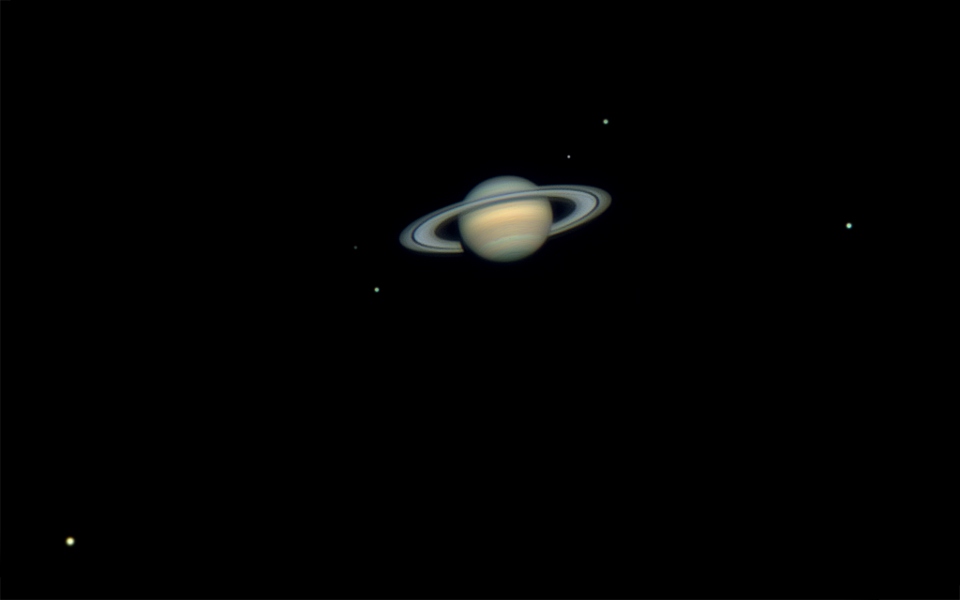 Source: How many moons does Saturn have? So far 62 have been discovered, the smallest only a fraction of a kilometer across. Six of its largest satellites can be seen here, though, in a sharp Saturnian family portrait taken on March 9. Larger than Earth's Moon and even slightly larger than Mercury, Titan has a diameter of 5,150 kilometers and starts the line-up at the lower left. Continuing to the right across the frame are Mimas, Tethys, [Saturn], Enceladus, Dione, and Rhea at far right. Saturn's first known natural satellite, Titan was discovered in 1655 by Dutch astronomer Christiaan Huygens, while most recently the satellite provisionally designated S/2009 S1 was found by the Cassini Imaging Science Team in 2009. Tonight, Saturn reaches opposition in planet Earth's sky, offering the best telescopic views of the ringed planet and moons.
__________________
1st in Kommisar's 2009 SM Tournament 1st in I Love You`s 2009 New Year`s Tournament 3rd in EnR's Mashfest '08 tournament 5th in Phynx's Unofficial FFR Tournament 9th in D3 of the 2008-2009 4th Official FFR Tournament 10th in D5 of the 2010 5th Official FFR Tournament 10th in D6 of the 2011-2012 6th Official FFR Tournament FMO AAA Count: 71 FGO AAA Count: 10 Bluearrowll = The Canadian player who can not detect awkward patterns. If it's awkward for most people, it's normal for Terry. If the file is difficult but super straight forward, he has issues. If he's AAAing a FGO but then heard that his favorite Hockey team was losing by a point, Hockey > FFR PS: Cool AAA's Terry - I Love You An Alarm Clock's Haiku beep beep beep beep beep beep beep beep beep beep beep beep beep beep beep beep beep - ieatyourlvllol |
|
|

|
|
|
#75 |
|
⊙▃⊙
|
What's in the sky tonight?
April 15, 2012 -Venus (magnitude –4.6; in Taurus) is shining the highest and brightest it ever appears in the evening sky during its 8-year cycle of repeating apparitions. Venus comes into easy view high in the west soon after sunset. It doesn't set in the northwest until around 11 or even midnight daylight saving time (depending on where you live). You can see Venus through the clear blue sky of day if your eye lands right on it; look for it 44° (4 or 5 fist-widths at arm's length) to the Sun's celestial east-northeast. Look high to Venus's upper right at dusk for Capella, to its lower left for Aldebaran, and to its lower right for the Pleiades. Far below Venus in twilight is Jupiter. The best time to examine Venus in a telescope is late afternoon or around sunset. It's now a thick crescent 30 arcseconds tall and 40% sunlit, waning and enlarging week by week as it swings toward Earth. -Keep careful watch on Saturn and its rings in a telescope. With Saturn at or near near opposition, notice the Seeliger effect: a temporary brightening of the rings with respect to the globe. This happens because the solid particles making up the rings backscatter sunlight (reflect it back in the direction it came from) more effectively than the planet's cloudtops do. Compare how the rings and globe look now with with how they look a week or more past opposition. Astro Picture of the Day: April 15, 2012 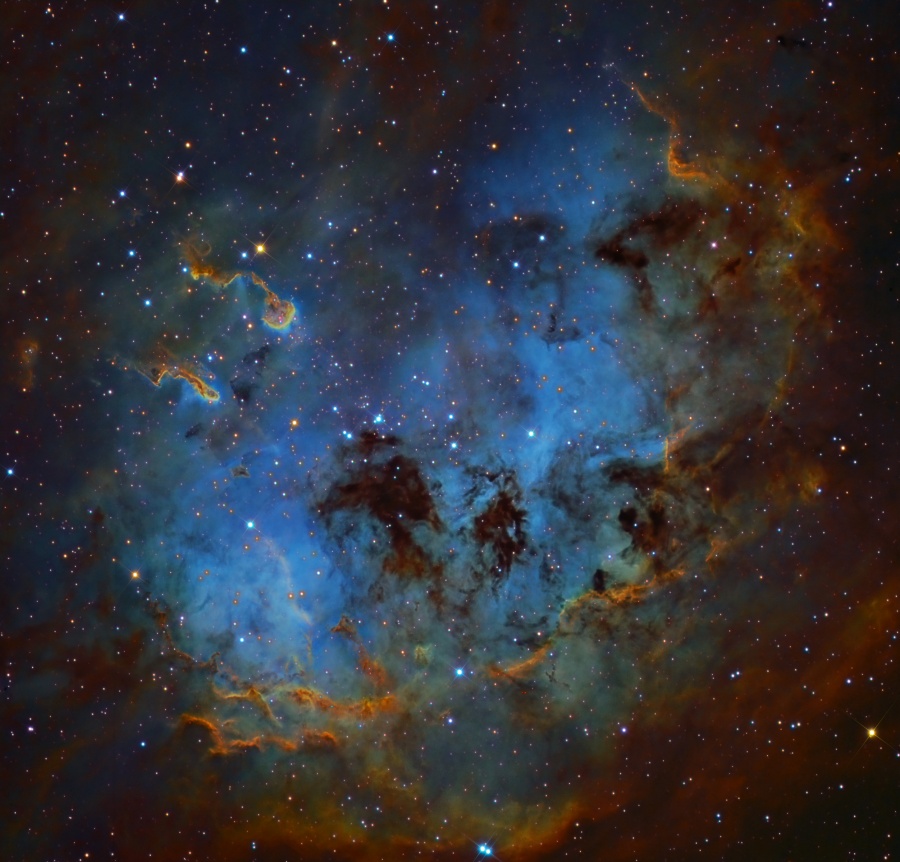 Source: This telescopic close-up shows off the otherwise faint emission nebula IC 410 in striking false-colors. It also features two remarkable inhabitants of the cosmic pond of gas and dust above and left of center, the tadpoles of IC 410. The picture is a composite of images taken through both broad and narrow band filters. The narrow band data traces atoms in the nebula, with emission from sulfur atoms in red, hydrogen atoms in green, and oxygen in blue. Partly obscured by foreground dust, the nebula itself surrounds NGC 1893, a young galactic cluster of stars that energizes the glowing gas. Composed of denser cooler gas and dust the tadpoles are around 10 light-years long, potentially sites of ongoing star formation. Sculpted by wind and radiation from the cluster stars, their tails trail away from the cluster's central region. IC 410 lies some 12,000 light-years away, toward the constellation Auriga.
__________________
1st in Kommisar's 2009 SM Tournament 1st in I Love You`s 2009 New Year`s Tournament 3rd in EnR's Mashfest '08 tournament 5th in Phynx's Unofficial FFR Tournament 9th in D3 of the 2008-2009 4th Official FFR Tournament 10th in D5 of the 2010 5th Official FFR Tournament 10th in D6 of the 2011-2012 6th Official FFR Tournament FMO AAA Count: 71 FGO AAA Count: 10 Bluearrowll = The Canadian player who can not detect awkward patterns. If it's awkward for most people, it's normal for Terry. If the file is difficult but super straight forward, he has issues. If he's AAAing a FGO but then heard that his favorite Hockey team was losing by a point, Hockey > FFR PS: Cool AAA's Terry - I Love You An Alarm Clock's Haiku beep beep beep beep beep beep beep beep beep beep beep beep beep beep beep beep beep - ieatyourlvllol |
|
|

|
|
|
#76 |
|
FFR Simfile Author
|
Fantastic thread, even for casuals just looking at the pictures.
I absolutely love the picture from April 12. I don't see this video posted anywhere in this thread, so: http://www.youtube.com/watch?v=FG0fTKAqZ5g An incredible time-lapse from the ISS for those interested.
__________________

|
|
|

|
|
|
#77 |
|
Signature Extraordinare~~
Song Submission & Events Manager
|
This thread is the most up-to-date thread I've ever seen. D:
|
|
|

|
|
|
#78 |
|
Quasi-porn
|
Even though I don't understand a lot of it. The pictures are amazing and open my eyes to what we're all missing out on. There's just so much we don't know.
|
|
|

|
|
|
#79 |
|
⊙▃⊙
|
Thanks Reach, gold stinger, Winrar for the positive feedback! Reach, I have added the ISS video under the ISS tab because that's a great video and really gives perspective on what it's like to see the Earth from above.
If there's something you want to see added to the thread, post a suggestion! It might just start appearing in the main post. What's in the sky tonight? April 16, 2012 -As twilight fades, Look for bright Sirius in the southwest, Orion's horizontal Belt off to the right (with Betelgeuse above it, Rigel below it), and Aldebaran and Venus farther to the right in the west. As it sinks ever lower in the west, notice how it starts twinkling more violently, even temporarily changing colours to yellows and reds. Why is this? As it lowers into the horizon, Sirius and other stars have more atmosphere to travel to from your eyes to the location of the star. Because of this, the light of the star is often distorted through the increased atmosphere and can be strong enough to change what colour rays reach your eyes. This is the same reason why the Sun rises reddish in colour, and why the moon also rises in a red-orange colour. It also explains their often distorted and enlarged shape. Take this picture of the sun for example.  -Mercury (magnitude +0.4) is deep in the glow of sunrise. It's having a very poor dawn apparition just above the eastern horizon. -Neptune (magnitude 7.9, in Aquarius) is barely emerging into view low in the east-southeast before dawn's first light. Both of these planets were hidden in the glare of the sun last week. Astro Picture of the Day: April 16, 2012 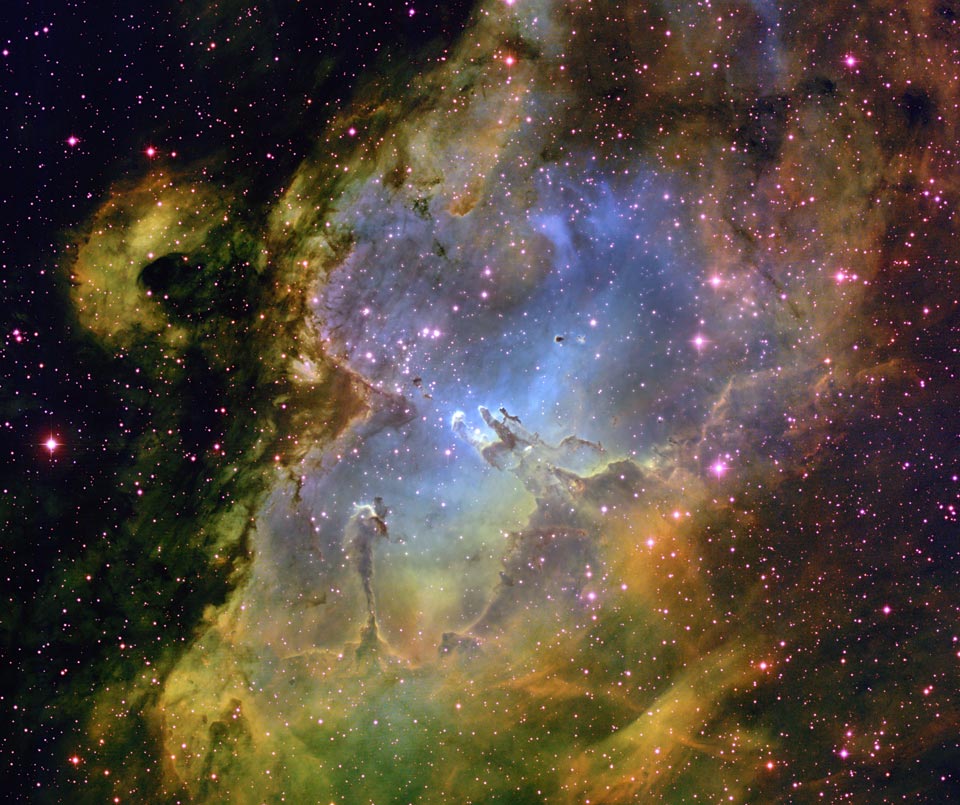 Source: From afar, the whole thing looks like an Eagle. A closer look at the Eagle Nebula, however, shows the bright region is actually a window into the center of a larger dark shell of dust. Through this window, a brightly-lit workshop appears where a whole open cluster of stars is being formed. In this cavity tall pillars and round globules of dark dust and cold molecular gas remain where stars are still forming. Already visible are several young bright blue stars whose light and winds are burning away and pushing back the remaining filaments and walls of gas and dust. The Eagle emission nebula, tagged M16, lies about 6500 light years away, spans about 20 light-years, and is visible with binoculars toward the constellation of the Serpent (Serpens). This picture combines three specific emitted colors and was taken with the 0.9 meter telescope on Kitt Peak, Arizona, USA. The famous pillars are seen at the centre of this nebula.
__________________
1st in Kommisar's 2009 SM Tournament 1st in I Love You`s 2009 New Year`s Tournament 3rd in EnR's Mashfest '08 tournament 5th in Phynx's Unofficial FFR Tournament 9th in D3 of the 2008-2009 4th Official FFR Tournament 10th in D5 of the 2010 5th Official FFR Tournament 10th in D6 of the 2011-2012 6th Official FFR Tournament FMO AAA Count: 71 FGO AAA Count: 10 Bluearrowll = The Canadian player who can not detect awkward patterns. If it's awkward for most people, it's normal for Terry. If the file is difficult but super straight forward, he has issues. If he's AAAing a FGO but then heard that his favorite Hockey team was losing by a point, Hockey > FFR PS: Cool AAA's Terry - I Love You An Alarm Clock's Haiku beep beep beep beep beep beep beep beep beep beep beep beep beep beep beep beep beep - ieatyourlvllol |
|
|

|
|
|
#80 |
|
⊙▃⊙
|
What's in the sky tonight?
April 17, 2012 -The eclipsing variable star Algol is at minimum brightness, magnitude 3.4 instead of its usual 2.1, for a couple hours centered on 10:44 p.m. EDT (9:44 p.m. CDT). This is the last chance till August to see Algol at minimum from the latitudes of the U.S. -Mercury (magnitude +0.4) is deep in the glow of sunrise. It's having a very poor dawn apparition just above the eastern horizon. -Keep careful watch on Saturn and its rings in a telescope. With Saturn at or near near opposition, notice the Seeliger effect: a temporary brightening of the rings with respect to the globe. This happens because the solid particles making up the rings backscatter sunlight (reflect it back in the direction it came from) more effectively than the planet's cloudtops do. Compare how the rings and globe look now with with how they look a week or more past opposition. By April 12th, three days before Saturn's opposition, the planet's rings had already brightened quite noticeably due to the Seeliger effect. South is up. A comparison image by the same photographer has been posted below.   Astro Picture of the Day: April 17, 2012  Source: Antares is a huge star. In a class called red supergiant, Antares is about 850 times the diameter of our own Sun, 15 times more massive, and 10,000 times brighter. Antares is the brightest star in the constellation of Scorpius and one of the brighter stars in all the night sky. Located about 550 light years away, Antares is seen on the left surrounded by a yellowish nebula of gas which it has itself expelled. Radiation from Antares' blue stellar companion helps cause the nebular gas to glow. Far behind Antares, to the lower right in the above image, is the globular star cloud M4, while the bright star on the far right is Al Niyat.
__________________
1st in Kommisar's 2009 SM Tournament 1st in I Love You`s 2009 New Year`s Tournament 3rd in EnR's Mashfest '08 tournament 5th in Phynx's Unofficial FFR Tournament 9th in D3 of the 2008-2009 4th Official FFR Tournament 10th in D5 of the 2010 5th Official FFR Tournament 10th in D6 of the 2011-2012 6th Official FFR Tournament FMO AAA Count: 71 FGO AAA Count: 10 Bluearrowll = The Canadian player who can not detect awkward patterns. If it's awkward for most people, it's normal for Terry. If the file is difficult but super straight forward, he has issues. If he's AAAing a FGO but then heard that his favorite Hockey team was losing by a point, Hockey > FFR PS: Cool AAA's Terry - I Love You An Alarm Clock's Haiku beep beep beep beep beep beep beep beep beep beep beep beep beep beep beep beep beep - ieatyourlvllol |
|
|

|
 |
| Currently Active Users Viewing This Thread: 1 (0 members and 1 guests) | |
|
|